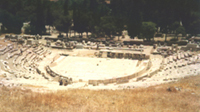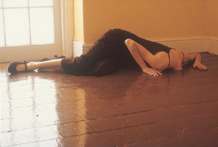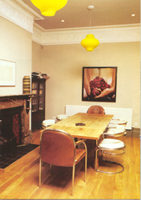Let's discover the far-fetched scenery
under the big blue sky...
|
I love doing performance. I like watching performance. But I am often confused by terms such as 'performing arts' and 'performance art'. In another words, what are the differences between 'performing arts' and 'performance art'? | |||
P E R F O R M I N G A R T SGenerally speaking, it refers to performance of drama, dance and music. The origins of performing arts can be traced back to the Greek Theatre, which was originally a religious rites. Protagonists, like priests and worshippers were dressed in animal skins, used speeches, dance, songs etc to stage a play which moved audience's emotion. By nature it is a kind of worship rites and competition entertaining the public. From the Medieval Theatre, commedia dell'arte to Elizabethan Shakespearean Theatre, theatre carried its function of entertainment. Contemporary playwrights such as Henrik Ibsen, Anton Chekhov and Bertolt Brecht asserted that theatre should be socially critical. Theatre still remains its state as a literary medium. Theatre is often taken as a container of drama, dance, music etc and thus as a main corpus of performing arts. In contemporary theatre, the emergence of genre such as 'dance theatre', 'music theatre' and 'visual theatre' proves how various non-text-based forms of performing arts, a plural noun, are represented by a single term that is theatre. Theatrical performance is a narrative which represents a story with united characters, plot, time and space. Audience enters a momentary and imaginary world of a play which mimics reality. According to Aristotle's Poetics 1, which is believed to be the root of theatre aesthetics, the process of which audience are having an emotional experience of the play and then return to reality can be referred to a dramatic function called 'catharsis', an emotional purification. In an attempt to converge performing arts into theatre, the literary narrative, or the emotional representation of storytelling, becomes the core of its form and structure. Dance and music are also considered to be literary media as well. |
|
||
| |||
|
|
P E R F O R M A N C E A R TPerformance manifestos, from the Futurists to the present, have been the expression of dissidents who have attempted to find other means to evaluate art experience in everyday life. 2 (Goldberg, 2001:8) Roselee Goldberg's pioneering research on the history of performance art in the last century traced performance art back to Futurism, Constructivism, Dadaism, Surrealism, etc in which artists began making art using live presence as protest against the then prevailing ideas on art. Artists started walking out from galleries and into public space, where they explored the rather transient and unstable nature of performance than traditional art, using their bodies as medium and having an art of ideas over product. During the 60s and 70s, the heyday of performance art as described by Goldberg, the development of live presence took on a more established form. Under Allan Kaprow's flagmanship, 'Happening' emerged as a form of performance art. Kaprow who studied with John Cage in The New School of Social Research in New York did his '18 Happenings in 6 Parts' in 1959 3. In this work, three rooms in Reuben Gallery were divided into 6 parts, in each of which audience were invited to participate, experience the happenings inside. 'Happening', defined by Kaprow as 'something spontaneous, something that just happens to happen', became a widely accepted label for this form of performance art. I have heard more than once people's complaint about happenings -- 'Doesn't something spontaneous mean not serious at all?' Indeed the so-called 'something spontaneous, something that just happens to happen' is an attempt to devolve things back into natural nobility 4. Even in some 'spontaneous' chance performances such as Cage's Theatre Piece (1960) inspired by I-Ching, the Chinese book of Changes, and Dick Higgins' The Tart (1965), musician, actors, dancers etc were performing according to the randomly picked movement, sound and style but there remained fundamental conceptual structures of generating randomness. Also, the problem of being 'not serious' involves how we see happening as a spontaneous event. Unlike traditional performing arts or theatre, happenings have no plot or storyline but are merely an event. Performers in happenings are not in certain characters but performing definite tasks. The 'spontaneous' event is not in a mimicked external time-space matrix but is real-time and real-space with audience in a natural setting. Michael Kirby points out that elements in happenings such as performers' movement, speech, music, images, costume, props or objects, setting or installation are alogical because they do not necessarily relate to each other and thus do not constitute a information structure of an imaginary time-space 5. While theatre employs narrative that requires unity and emotional involvement, happening as an established form of performance art is a spectacle of non-linear actions and concepts that challenge existing frameworks of art-making practices and are closer to conditions of daily life. At this point, how can we map performance in the scene where linear literary means of expression is often so dominant? | ||
| |||
L I V E A R TIn recent years, 'live art' becomes a fashionable term in the UK. 'Live art' or 'live events' often appear in some arts centres' programme diaries of events in theatre and galleries.One thing you can say with certainty about Live Art is that no-one has ever quite agreed what it is. Appropriately, its slippery shape and ever shifting borders are just two reasons why Live Art is such an exciting and challenging territory to occupy: it is constantly asking 'what is art, what can it do, what is its role, what is its value, what is its legacy...? (Keidan, 1999:2) 6 Therefore, live art is not a rigid art form but an ever-changing concept that is its attitude and strategy. People may think live art that maintains the unstable and slippery form and works against establishment is the British version of performance art that originated in the US. Live art indeed also conveys tolerance when taking into account all kinds of practices involving artists' live presence in their works. For example, happenings, theatre, dance or any other obscure works which explore time, space and ideas about the arts can all be put under the umbrella term of live art. 'Live art is a strategy to frame this diversity of conceptual, ephemeral and unrestricted practices...' 7 Given that performance art is the about performance of action, live art thus highlights the liveness of performance or the alive of lived experience of art. Here, I would like to share with you my experience of 'viewing' a live art event in London last year. It was Eve Dent's Anchorage presented in 'home' located in Camberwell, an off-centre residential area in South London. I walked down streets off the main road in the area and tired to find the right house number among those old attached Victorian houses. The feeling was like visiting my friends living there when I called at the door and was invited to sit down in their sitting room and have a drink before the performance started. 'home' aims at turning a historical building into a living space as well as an exhibition space or live art venue 8. The performance took place in the attic and the cellar. Upstairs a hand getting out of a hole on the wall was stretching and holding tight occasionally. Downstairs a foot was dripping water between steps of the wooden back stairs. In between the hand and the foot, there are Franko B's installations etc and guests drinking and chatting in the dining room or sitting room. There is no story which stirred up your emotions, and the concept of using non-presence to represent presence is much more explicit than what you can 'see' on the spot. More importantly, viewers and performers are not absolutely opposed, but are both building up the event in the real time and space of everyday life. |
| ||
Why do I love doing performance? Why do I like viewing performance? These questions come back to me again and again. Probably it is because of the excitement caused by getting or losing hold of the instantaneous and ever-changing moment of live performance. The glitter of liveness is far more appealing than boring deadly establishment. If 'performing arts' and 'performance art' are differentiated terms which determines the borders of different art forms according to their natures, 'live art' is rather a shifting flag which keeps on marking a wider exploratory framework for performance and striking for people's boarder horizons of what 'performance' can be. In between the entrenchment of visual arts and performing arts, live art seems to push towards the boundaries and open the door to broadmindedness and acceptance of every existing or potential possibility of performance. What is live art? Probably it is to open up our mind, to take a fresh breath and to discover the far-fetched and unexpected scenery under the wide big blue sky...
|
|||
» Published in PS -- visual arts and culture magazine, issue 20, Spring 2003, HK
by: © wen yau 2003 |
| remarks: |
1. What Aristotle refers 'poetics' to is indeed dramatic art. From this, drama is emphasized as a linguistic and literary medium. 2. Roselee Goldberg: Performance Art: From Futurism to the Present, Thames & Hudson, 2001 (first published as Performance: Live Art 1909 to the Present, World of Art series, 1988) 3. Allan Kaprow, 18 Happenings in 6 Parts, Reuben Gallery, New York, 1959 4. Darko Suvin: 'Relections on Happenings', Mariellen R Sandford (ed), Happenings and Other Acts, Routledge, 1995 5. Michael Kirby: 'Happenings: An Introduction' & 'The New Theatre', Mariellen R Sandford (ed), Happenings and Other Acts, Routledge, 1995, p.30-47 6. Lois Keidan: 'LIVE ART - what is it and what can we do with it?', On Tour: British Drama and Dance, Issue 14, 08/1999, p.2-3 7. Ditto 8. 'home' used to be a family house which had not been touched since the 1930's and is built on pentagram design. Laura Godfrey-Isaacs who brought the house and renewed it is a self-employed art consultant and curator specializing in purchasing and installing artwork for commercial sector. The living environment of 'home' provides 15 spaces to generate live art and exhibitions, such as Franko B's 'Pinball' in the sitting room featuring numerous images of god and 'Oh Lover Boy', an neon in the bathroom. 'home' where Godfrey-Isaacs lives with her family is open to public every Thursday and by appointment. |


